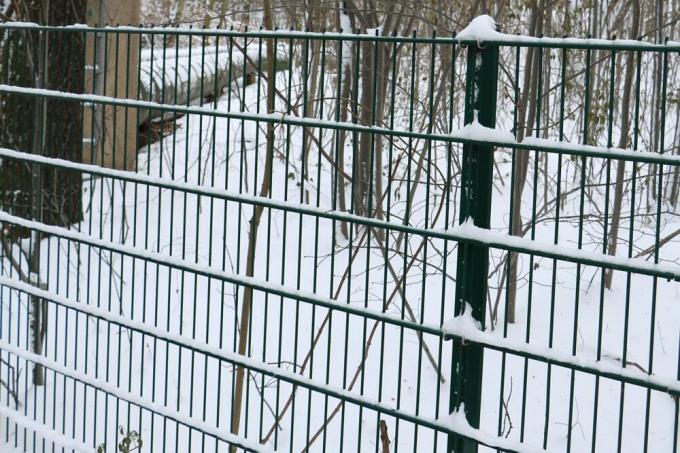

Table of contents
- private law vs. public law
- public law
- private right
- Allowed or not?
- 1. building planning law
- 2. Building Code Law
- 3. traffic law
- Private law – flexible and case-by-case
- Conclusion: yes or no?
Almost as safe as the lawn, a fence is part of your own garden design. It prevents unauthorized persons from entering your own property and protects privacy. In order to be able to make optimal use of your own garden, the fence is usually erected directly on the property line - and in many cases arouses resentment, annoyance or even arguments there. But what can you actually build at the border and is a real fence actually allowed? We provide information on the legal framework and different perspectives.
private law vs. public law
What is permitted and what is not is laid down in German law for a large number of subjects and even individual cases. But anyone who thinks that everything is clearly defined and can be easily read is wrong. Because different areas of law have their own perspectives on one and the same topic and can come to very different conclusions. When it comes to the fence at the property line, the biggest difference is the fundamental division into private law and public law.
public law
Here the legal relationships between the state and an individual, in our case the creator or Garden fence owner, settled. In principle, clear permissions and prohibitions are defined here, to which everyone living within the jurisdiction of the state must adhere. In our case, the following legislation, which may be affected by the fence on the border, is part of public law:
- building planning law
- Building Code Law
- traffic law
private right
In contrast to this is private law. It regulates how private parties, i.e. people, groups of people or organizations, deal with each other. The state is only active in the role of supervisor, but apart from enforcing this right, it does not appear as a party with its own interests. In the case of fencing on the property line, this is primarily the neighborhood law.
Allowed or not?
– That’s what the legal departments say –
Now that it has become clear how many areas of law from how fundamentally different categories can be answered when answering the simple question “May I put a fence on the property line?”, it also becomes clear that there is probably no clear and, above all, simple answer becomes. It is best if we proceed step by step and look at the individual subject areas one after the other in isolated form:
1. building planning law
The Building Code (BauGB) applies here. And that uniformly throughout Germany. This law does not make any specifications for fences, walls or other so-called “enclosures”. However, the development plans are based on it, which is certainly known to everyone who has ever built. The development plans are regulated in Paragraphs 8 to 10 of the Building Code, and Section 30 also provides essential information on the application of the land use plan created in this way. In development plans, there may be specifications for:
- general admissibility of fences
- Type, material and appearance of permissible fence systems
- Altitude Limits
- areas to be kept clear of fences.

So if there is a development plan for your own building plot, it is very easy to see from this what is generally possible in terms of fences and what is not permitted. Very seldom are there very direct specifications in relation to the current question as to whether the construction may actually take place on the property line, or whether a boundary distance may have to be observed is.
Tip:
If there is no information about the fence in the development plan, you don't have to despair. This means quite simply that the building planning law does not make any specifications or restrictions.
2. Building Code Law
In contrast to building planning law, building law does not regulate what can be built, but how it must be built. Since this area of law is regulated in the so-called state building regulations, each federal state can set its own specifications here. However, the orientation is usually based on the so-called model building code, which contributes the majority of all specifications. If you are looking for information on garden fences here, you will not find anything about admissibility at borders. However, if there are design specifications for fences in a development plan, from a legal point of view these originate from the building code law, so that they should be mentioned here for the sake of completeness.
Tip:
A legal trick of the state building regulations is the so-called application for exemption. If a development plan prohibits you from building a fence on the property line, you can apply for an exemption from this prohibition. With a plausible justification, it may be that you can then implement your enclosure according to your wishes.
From state to state
Although no answer to our question, it is still good to know that fences according to model building regulations and almost all state building regulations that have been introduced can also be set up without any procedures within a certain framework may. This means you can build your fence without having to submit an application first. In terms of content, there is a consistent definition with one exception, whereby the place of writing can vary from case to case:
a) Freedom of procedure up to a height of 2.00 m
Both the model building regulations and almost all other building regulations grant freedom of procedure for erecting a garden fence up to a height of 2.00 meters. You can read about this in the following paragraphs, for example:
- Model building code §61
- Bavarian building code §58
- Hessian building code §63
- Rhineland-Palatinate state building code §62
b) General freedom of procedure
Baden-Württemberg is the only federal state to have eliminated the height limit for fences that can be erected without a planning application from its legal text. According to Section 50, you can build enclosures of any type and dimension without an application, provided that the other admissibility criteria are met.
Tip:
So it's worth not looking for a paragraph with a number, but much more for the keyword "procedural freedom" in the table of contents of the applicable state building code!
3. traffic law
If you live at a street crossing, it is possible that a fence erected directly at the border will obstruct the view of vehicles in the area of the crossing. Then traffic law issues can represent a prohibition for your enclosure. You don't have to judge for yourself whether this is also the case for you. It is particularly easy again if there is a development plan. Because this also takes up traffic law issues and, in the event of a visual impairment, clearly specifies where the fence may be erected and, above all, where not.
Where is what in traffic law?

On the other hand, if this is not specified in the development plan, it is worth making a brief inquiry to the local regulatory office. The employees of this authority can quickly give you information as to whether there is something standing in the way of your project. On the other hand, if you start looking for a written legal basis yourself, you will unfortunately have little success without relevant knowledge of traffic law. Because in traffic law, countless individual subject areas with their own regulations combine to form a coherent area of law. Possible restrictions for your fencing can therefore result from these areas of traffic law, for example:
- Road Traffic Act
- traffic regulations
- Country-specific regulatory law, e.g. B. State Violations Act
- community-specific statutes and regulations
As you can see, a wide variety of legal norms are involved here, some of which are federal, state or even municipal. Use the possibility of a central contact person in your municipality and avoid problems because you did not necessarily have an overview of all relevant subject areas!
Now all areas have been dealt with from which the state can issue a direct ban on your garden fence. If only one of the sub-areas comes out with a negative result, that is enough to make the construction impossible for you, or at least inadmissible.
Private law – flexible and case-by-case
It looks completely different in private law, so for you in matters of garden fences in neighbor law. Although there are clear guidelines as to what is permitted as an enclosure, they differ Specifications - again this is state law - very strong from state to state from each other. It is therefore definitely worth taking a look at the neighboring law of your own federal state in order to be able to rule out difficulties. On the other hand, there is no uniform federal law on this subject, since the relevant Sections 903 to 924 of the Civil Code do not make any specific statements about fences.
The federal states of Baden-Württemberg and Berlin are briefly presented here as extreme and strongly contrasting examples of fixings over fences.
a) Baden-Württemberg:
- allowed: fences directly on the border up to a height of 1.50 m
- also permitted: higher systems if the limit distance is at least 1.50 m or more
- E.g.: 2.00m height with 0.50m limit distance allowed because exceeding the 1.50m limit = 0.50m
- E.g.: 1.80m height with 0.20m limit distance NOT allowed, since limit distance only allows exceeding the 1.50m limit of 0.20m, but actually 0.30m
If you stick to these simple guidelines, your neighbor will have to put up with your fence system and will have no way of taking action against it.
DANGER:
Remember that in addition to these rules of neighbor law, public law must still be observed!
b) Berlin:
- no information on the distances to be observed depending on the height
- BUT: at the request of the neighbor obligation to fence (!!)
- Execution including fence height in the customary local measure, i.e. according to the type and dimensions of the fences in the area
- without comparison objects approx. 1.25 m high chain link fence

So now you can create a comparatively manageable query catalog from the respective Work through the state neighborhood law and finally to something that is positive for you, or negative result come. If you are allowed to build on the border, your request is fine and you can take action. If, on the other hand, your project does not correspond to the legal possibilities up to this point, you should don't give up immediately, but take a look back at the definition of private law throw:
- applies between private parties
- The state intervenes only as an enforcement authority
- Violations are not prosecuted of their own accord, but only when reported (!)
At this point, one thing becomes very clear: the state intervenes and punishes if neighbors' laws are not followed. But he only does it if the disadvantaged neighbor reports the matter and asks for support. If your fence is 2.00 m high directly on the property line, your neighbor can file a complaint and the state will ask you to remove the fence again. But: Your neighbor doesn't have to do that! If he agrees with your fence, he can also tolerate higher fences from you without having to become active. Because the neighbor law offers every neighbor a certain right to protection, but no obligation to make use of this protection.
Tip:
Therefore, when planning your fence, talk to your neighbors at an early stage to find out whether they have a problem with it or whether they might even welcome the separation of the two properties. If this is the case, you can confidently ignore the neighbors' law and clarify the public law issues that have already been dealt with!
Conclusion: yes or no?
In conclusion, the simple question of whether a fence is permissible directly on the border cannot be answered unequivocally. Instead, an answer remains in the form of Yes, if... with several query criteria that ultimately lead to reliable information. Therefore, check carefully before you deal with the purchase or the award of the contract to a craftsman.
 garden editorial
garden editorial I write about everything that interests me in my garden.
Learn more about property boundaries

border development | The right distance to the neighbors
Border development is only permitted under certain conditions and requires the consent of the neighbors as well as a permit. The differences that apply vary from state to state.

Setting lawn borders: instructions + dimensions, weights and prices
Setting a lawn border makes sense to prevent the grass from spreading in paths and beds or even to create accurate beds in the middle of a meadow. Here you will find instructions, dimensions, weights and prices for various lawn borders.

Make your own wicker fence
If you really want to use your garden, you have to plan for a privacy screen. Because not always and not in every state of clothing you want to be looked at over the garden fence by passers-by. Sometimes just the intimacy that a well-placed privacy fence lends leads to a relaxed gardening experience.

Plants for border planting
In itself, every plant is suitable for border planting, the question is more whether you want to create a privacy screen through appropriate planting or not. Then fast-growing shrubs should be chosen, which are brought into the right shape by regular pruning.

Cladding the garden wall: 13 ideas for wall cladding
Lovingly designed flower beds are only half as beautiful when a gray concrete wall rises up in the background. Unfortunately, this cannot be removed so easily. No problem, because there are other ways to visually enhance the garden. This guide has many creative ideas for covering a garden wall.

Build a wall of ruins in the garden yourself - this is how an antique wall works
Building a wall of ruins in the garden yourself is comparatively easy - if you have the necessary knowledge. It can serve as a privacy screen, be planted or separate different garden areas from each other. Interested parties can find out how ancient walls are made and what is required for this here.
